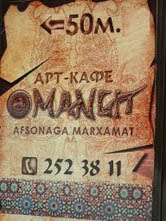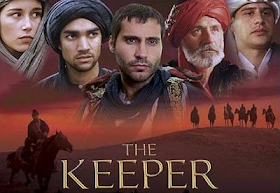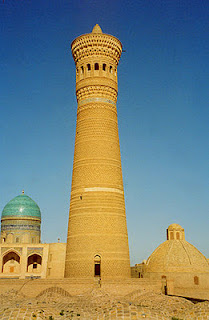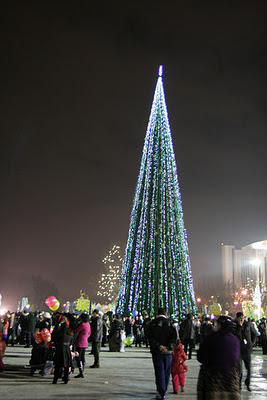 |
| Suzanna Fatyan |
Suzanna Fatyan, one of Uzbekistan's finest tour guides, is also an
obsessive foodie. She hunts down seasonal foods, and visits markets and
restaurants all over Uzbekistan. Suzanna will contribute regular articles
recommending the best places to eat in the cities visited on Uzbek
Journeys tours, as well as pieces about Uzbek cuisine.
Following her review of Samarkand restaurants and cafés, Suzanna now takes
us to Tashkent, where she has sampled some fine meals and local specialities.
Tashkent is Uzbekistan's capital city and during the last 100 years the most common epithet applied to Tashkent is ‘
the city of bread’. This epithet is perceived as part of the city’s history, part of a time when Tashkent became a refuge and subsequent homeland for the witnesses and participants of the upheavals of the 20th century, such as the devastating earthquake of 1966.
For many people Tashkent is synonymous with warm hearts, humanism, and a willingness to receive everyone in need with open arms. Being a Central Asian city, Tashkent sometimes has features one finds in Warsaw, St. Petersburg and other European cities. At the same time it has some ‘secret’, authentic corners known mostly to its inhabitants and very experienced travellers.
Uzbeks and other Central Asians frequently visit cosmopolitan Tashkent for cultural diversions: its museums, galleries, sporting events, opera house and theatres. But many also come to taste its specialties that are not available in the rest of the country. The city offers a wonderful choice of international cuisine, milliy taomlar (‘national dishes spots’), coffee houses, steak restaurants and other places of interest for people who enjoy good food. Note that wifi in Tashkent cafes and restaurants is becoming more popular – just ask the code when you are seated.
 |
| Sunduk restaurant, Tashkent |
For a traveller who has just arrived in Uzbekistan, I recommend you start with light dishes, because the weather in the tourist season is generally hot and dry. So I suggest as a newcomer you start your food experience at
Sunduk, 63 Sadik Azimov Street, (tel: +998 71 232 11 46).
This cosy little restaurant offers dishes in the Uzbek and Russian traditions. While the restaurant has typical Uzbek salads of tomatoes and cucumbers, its menu also offers buckwheat porridge and oatmeal. Other Sunduk specialties are draniki (a kind of vegetable cutlet, very common in the Ukraine and Belarus), kompot (fruit or berries drink, not a juice), and very hot and very delicious pirojki (little pies) filled with mashed potatoes, cabbage or eggs and spring onions.
And for a dessert try the very good coffee brewed especially for you in a Turkish coffee pot. (These pots are most suitable for fortune telling from the coffee sediment at the bottom of the cup!) Other options are a cup of green tea, apple strudel and excellent homemade jam. And in summer there are outdoor tables. Sunduk is open for breakfast, lunch and dinner and is closed Sundays and public holidays.
 |
| Look for this sign to Mangyt |
In the evening, after you’ve successfully adapted to the heat, you will be ready for a nomadic atmosphere at
Mangyt restaurant not far from the Ucell office at 12 Usmon Nosir Street, (tel: +998 71 252 38 11). Mangyt is partly designed as a yurt and offers both Uzbek and Kyrgyz cuisine.
 |
| Inside Mangyt restaurant |
Although it’s not ‘cosy’, the atmosphere romantically evokes the Central Asian steppe. Mangyt’s main specialty is beshbarmak, a dish of boiled meat and noodles. The name means 'five fingers' because it is eaten with one's hands. Mangyt also offers dishes such as lamb ribs, kidneys cooked with meat and vegetables, and many more.
Tashkent is a perfect place for those who cannot imagine their life without cakes, pies and other sweets.
Café Bon, at 63 Shota Rustavelli Street (tel:+998 71 280-51-16) provides an excellent choice of desserts: esterhazy, sachertorte, scharlotka (apple cake), tiramisu and macaroons.
 |
| Café Bon for cakes and coffee |
Café Bon also has a branch at 21 Chimkentskaya Street, near the Ukraine café (tel: +998 71 150 18 33/34). Bon also has a good choice of coffee, fresh juices and ice creams. Both cafes are very cosy. Bon at Chimkentskaya has a downstairs room and also outdoor tables in summer.
Pizza is popular the world over and Tashkent is no exception. Pizza spots I would recommend with great pleasure are Bella Napoli and Semo di Roma.
Bella Napoli is next to Café Bon at 63 Shota Rustavelli Street, (tel: +99871-253-91-83).
Ristorante Semo di Roma 40 Chekhova Street, (tel: +99871 150 1835/36,) offers indoor service as well as outdoor seating on a wonderful terrace: it’s a perfect place for warm Tashkent evenings.
If you are homesick for steaks, the best steaks to my mind are at the cool, modern
Studio Café, at Sadik Azimov Street, (tel: +998 71 233 0601) not far from Sunduk.
 |
| Outside Milliy Taom |
And now the most important: this is paradise for a food lover who would like to try very traditional Uzbek dishes and see the food preparation process. As frequently happens in Uzbekistan, there is no restaurant sign but is easily recognized, even from a distance, because of the number of people nearby. This place is located not far from the Tashkent circus, at Gafur Gulyam Street. The image to the left may help you find it. Or simply ask. Among Tashkent restaurants, this café is known as
Milliy Taom (it means ‘national dish’). Your first impression when you enter the cafe is that you have arrived for a royal feast or traditional Uzbek wedding: huge boiling pots, amazing looking food, and a wonderful, seductive aroma.
 |
| Tashkent shurpa served in clay pots at Milliy Taom |
In Milliy Taom you can find naryn, a cold snack popular in Tashkent, made of finely sliced dough and meat. You can also try fabulous shurpa, a dish I wrote about in my Samarkand restaurant article, but this time with distinctive Tashkent features served in little clay pots.
Milly Taom also serves true Uzbek specialties such as hasip (traditional home made sausage), halim (porridge usually cooked for the Navruz festival), chuchvara (Uzbek ravioli), kazan kabob (lamb dish), delicious potatoes cooked in kurduk oil (fatty tail oil) or with lamb. These dishes are available only at lunchtime and Milly Taom is not open at night. It is such a special, authentic place and I strongly encourage you to visit.
For a farewell dinner I would recommend
Caravan One at A. Kahhar Street (tel: 99871 255 11 99/ 255 696). It offers Uzbek and European food in a stylish atmosphere. Another good option is
Amaretto at 28 Shota. Rustavelli Street (tel: +998 71 215 55 57). It offers a synthesis of Italian and local food). You can also try
Gruzinskiy Dvorik at 15 A. Kahhar Street, (tel: +998 71 129 07 70), a Georgian restaurant offering not only Georgian food but also excellent wine.
Enjoy your stay in Tashkent!
Related posts:
Uzbekistan for Vegetarians
The Glory of Uzbek Bread
Celebrating Nowruz - Spring New Year in Uzbekistan
Samarkand Restaurants and Cafés: An Insider's View
Bukhara Restaurants and Cafés: An Insider's View
Contact Suzanna via email:




















